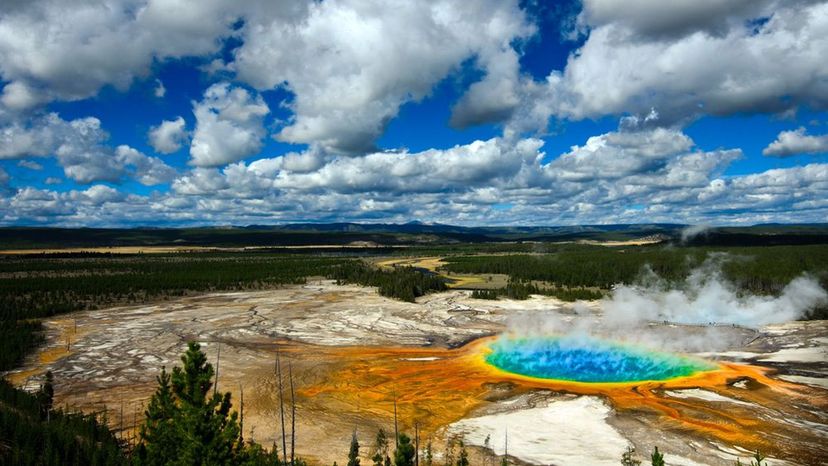
About This Quiz
It is the most famous national park on planet Earth. How much do you know about America's renowned Yellowstone National Park?In 1869, the Cook-Folsom-Peterson Expedition wandered through Yellowstone's mesmerizing landscapes. The month-long journey documented many of the area's colorful and bizarre features.
Yellowstone's boundaries extend into three states, including Wyoming, Montana and Idaho. Almost all of the park is within the state of Wyoming.
Yellowstone was indeed the world's first national park. Its unique geography and unusual beauty made it an obvious choice for long-term preservation.
Advertisement
Yellowstone encompasses about 3,500 square miles of territory. That means the park is roughly 2.2 million acres, making it one of the top 10 national parks in the country in terms of size.
About 640,000 years ago, a volcanic blast shattered the area. Now, the Yellowstone Caldera remains. It has a huge magma chamber that could someday result in another gigantic eruption.
Many sensationalized media stories fixate on the Yellowstone super volcano and its potential for widespread destruction. However, scientists don't really expect the volcano to erupt anytime soon.
Advertisement
There are approximately 60 species of mammals in Yellowstone. The park is probably most famous for its large mammals, such as elk, bison and bears.
More than 4 million visitors witnessed Yellowstone's glory in 2015 alone. As the number of visitors increases, park managers struggle to find a balance between the wilderness experience and huge influxes of tourists.
To much fanfare (and controversy), authorities released gray wolves back into the area. They had previously been exterminated in 1926. Since 1995, the packs have grown and thrived within the park.
Advertisement
In 1959, a powerful earthquake occurred just outside the park's boundaries. There were huge landslides, widespread destruction, and the temblor caused new geyers to begin blasting into the air.
There are roughly 100 wolves in 10 packs that roam the park. The wolves are efficient predators and can weigh up to 130 pounds.
The park is a seismically active place thanks to its volcanic characteristics. It experiences 1,000 to 3,000 earthquakes per year, and most of these quakes are minor.
Advertisement
The park was established in 1872, just a few years after the end of the American Civil War. The president who signed the dediction was Ulysses Grant, a celebrated war hero.
More than 500 people were injured by bears in the 1930s, a time when it was socially acceptable to feed the bears scraps of food. The practice was eventually banned to save both people and bears.
The 1988 fire was so large and dangerous that the park was actually closed for a time. The flames scorched one-third of the park's forests.
Advertisement
Around 9,000 firefighters were called to the scene to try and slow the immense fire and thousands of military personnel assisted the effort as well. The fire was so big that the smoke could be seen drifting through the atmosphere hundreds of miles from the park.
Thomas Moran created the colorful and majestic canyon in his famous painting. The painting inspired untold numbers of people to travel to Yellowstone to see the canyon with their own eyes.
Elk thrive in Yellowstone's sprawling territory. There are perhaps 30,000 elk roaming throughout the park.
Advertisement
It's a wolf-eat-wolf park -- the No. 1 killer of wolves in Yellowstone is other wolves. Outside the park, though, humans are the No. 1 threat to wolves.
There are about 500 active gesyers in Yellowstone. That's roughly half the number of the entire planet's active geysers.
Old Faithful is the park's most famous (and reliable) wild performance artist. It erupts roughly every 90 minutes, drawing scads of tourists who encircle the geyer to see its magnificance.
Advertisement
Certain types of algae have evolved to withstand the extreme heat of the hot springs. Their lifecycles create various shades of green, red, orange and brown that contrast with the water's deep blues.
There are 12 established campgrounds with approximately 2,000 camping sites. With proper planning and the right permit, motivated tourists can camp in the park's less-traveled backcountry.
In 1877, a group of Nez Perce Indians being chased by the U.S. military snagged unsuspecting tourists for a short time. Two of the tourists were killed. Eventually, the band of natives surrendered at the end of the so-called Nez Perce War.
Advertisement
The deepest point of the colorful 24-mile long canyon is about 1,200 feet. The Grand Canyon in Arizona, by comparison, is up to 7,800 feet deep.
In the park's long history, only eight people have been killed by bears. The most recent death occurred in the summer of 2015 when a lone hiker encountered a mother bear guarding her two cubs.
More people die from Yellowstone's hot springs than bears. Some people accidentally slip and fall into the boiling-hot pools; others make the mistake of thinking the springs are safe for a warm bath -- they are, in fact, treacherous places to take a dip.
Advertisement
During the warm summer months, when school is out of session, many millions of people make their treks to the park. July is the busiest month, and in some years perhaps 1 million people visit during that 31-day span.
All human-caused fires are battled. Those started by natural causes, on the other hand, are subject to review. Wildfires are a necessary part of the ecosystem's cycle and often help to reinvigorate areas o old growth.
Bears aren't interested in conflict with humans, particularly in the park's developed areas. Your chance of being attacked in those areas is only around 1 in 23 million. You're much more likely to be hurt in a car accident navigating the throngs of nature-crazed visitors.
Advertisement